
|
Deaths Scenes 1946-1947 |
| Film Title/Year and Description | ||||||||
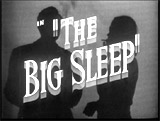
|
Gang boss/gambler Eddie Mars (John Ridgely) was compelled by Philip Marlowe (Humphrey Bogart) to run outside Geiger's house into gunfire from his own gang members, who were waiting outside with guns ready to blast away during an ambush. They were expecting Marlowe to be fleeing after killing Mars. Marlowe wounded Mars in the arm ("That's one, Eddie") and then ordered the gang boss to go out the front door, where his own gang would undoubtedly kill him. Thinking that the crazed detective was going to shoot him after he shot again ("That's two, Eddie"), Mars raced out the front door, vainly shouting: "Don't shoot! It's me, Mar---." Machine-gun bullets (meant for Marlowe) from his own henchmen hit him. A dotted-line of bullet holes in the door signaled Mars' murder outside. A mortally-wounded Mars slowly re-entered the room and collapsed to the floor in the front hallway after the unusual death. |
 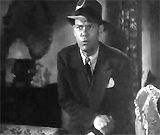 Mars Wounded by Marlowe  Line of Bullet Holes on Door 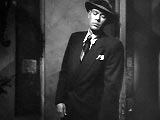 Death Via Gunfire Through Door |
||||||
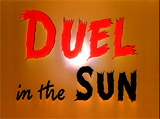
|
The two doomed lovers, fugitive outlaw Lewt McCanles (Gregory Peck) and half-breed Pearl Chavez (Jennifer Jones) crawled to each other and died in each other's bloody arms after a shoot-out at Squaw's Head Rock. The final notorious, and infamous show-down scene was the climax of all their confrontations together. When Lewt appeared in the rocks at a long distance from her, Pearl took aim and shot her lover to end their passionate love-hate affair. She showed immediate remorse, thinking he was dead. But he was still alive, although wounded in the leg. He fired back, calling her a "double-crossin' bobcat." Pearl was still drawn to him, re-cocking her gun and moving forward. As she approached, Lewt shot Pearl in the chest, sending her bloodied body into the rocks and rubble. Satisfied that he had killed her, he said: "I guess that does it," but then felt twinges of regret that he had shot his beloved, calling out "Pearl, hey Pearl!" The ex-lovers continued their bloody shoot-out in the hot desert sun and Lewt was shot in the stomach, and he told her: "I can't shoot no more, honey. Honest." Seriously wounded, she dragged herself over the rocks and up the side of the mountain toward her dying lover, while spouting blood and shouting threats ("I'm not scared of you. I'm coming up after you"). Dying, Lewt asked Pearl:
In their final moments, she cried out for him: "Lewt, hold on Lewt, Hold on. Wait for me, Lewt," and lustfully crawled toward him, as she slid back with her grasp of sand. When she finally reached him, they stretched their hands out toward each other:
They bloodily embraced and died in the dust in each other's arms. As they died, the camera pulled back until they were lost in the landscape under the blazing, hot sun, under the massive face of Squaw's Head Rock. |
 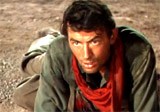 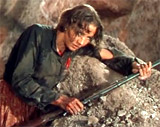 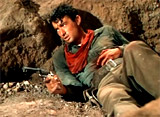  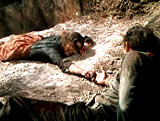
Lewt vs. Pearl |
||||||
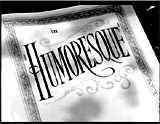
|
Humoresque (1946) The title of director Jean Negulesco's and Warner Bros.' romantic drama meant "a short, lively piece of music." The suicide scene at the end of the film was anything but short. The tagline was: "A Beautiful Woman Is Most Dangerous When She's in Love." The screen play by Clifford Odets and Zachary Gold for the rags-to-riches tale of doomed love was based on a story by Fannie Hurst. In the story, classical music violinist Paul Boray (John Garfield) from a lower-class background was brought up during the Depression Era. He engaged in an illicit affair with rich, attention-seeking, glamorous socialite Helen Wright (Joan Crawford). She was emotionally enraptured and intrigued by his musical talent (and sexually desirous of him) and promised to help him become established. In the concluding sequence at her beach house, the self-loathing, unstable and lovelorn Helen was dressed in a glittering black sheath gown (with shoulder pads). During a long and emotional telephone conversation with Paul who was about to perform on the concert stage at the Metropolitan Hall, Helen realized that Paul was more dedicated to his career of performing, his music and his artistry than to her, so she decided to commit suicide:
As she downed a bottle of whiskey (she toasted herself: "Here's to love and here's to the time when we were little girls, no one asked us to marry!") and listened to Paul performing at the concert on the radio (Wagner's The Liebestod from Tristan and Isolde), Helen prolonged her grand finale death scene - a riveting and melodramatic moment. She took 10 minutes to finally drown herself. She stumbled onto her terrace, then down to the beach (clutching a crumpled-up flyer with Paul's photograph advertising his guest solo performance at the Metropolitan Hall), with the moonlight illuminating the tears on her face. She walked along the wave-line - where she submitted to the giant roaring waves that overtook her - there was a giant close-up of Helen's face accepting her fate.
Her death was symbolized by a close-up of the crumped and ripped flyer from her hand that was taken away by the surf. Helen had passed a man with a dog (in a game of retrieve the stick) - he looked back, but noticed she had disappeared and the beachside was empty (there was even an underwater shot of seaweed and bubbles where she perished). |
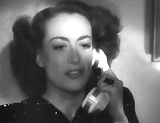 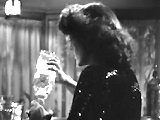   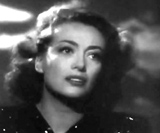  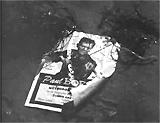 The Flyer |
||||||
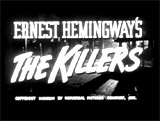
|
Director Robert Siodmak's intense, hard-edged, stylish film noir was a story of robbery, unrequited love, brutal betrayal and double-cross. A pair of hitman (William Conrad and Charles McGraw) executed the Swede/Pete Lunn (Burt Lancaster in his screen debut) who already had accepted his own sacrificial death and fate (off-screen) in his dark boarding house room. The camera panned down the length of the bed where the Swede lay passively in his shadowy, dim room in a white T-shirt - his head shrouded in darkness. Breathing heavily, co-worker Nick Adams (Phil Brown) burst into the Swede's boarding house room with the news that two men were coming to rub him out, but the resigned, immobile Swede responded stoically, calmly and with little surprise that there was nothing to be done to change his impending fate. With no strength to even rise from his bed, or will to run, the acquiescent and unresistant Swede awaited his physical sacrificial death - although he was already emotionally dead. In his last words, he mentioned that in his past, he had made one fatal error, and it had come back to haunt him: He rationalized:
Only a few minutes later, the fatalistic Swede calmly listened as the two cold-blooded gunman-executioners climbed the stairs to his cheap apartment room. He knew that his life wasn't worth living anymore. He half-rose from his bed as they opened the door and brutally emptied their guns of ten bullets into his body. Gunfire briefly illuminated the killers' faces. It was the ex-boxer's final knock-out. |
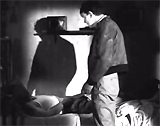 "I did something wrong - once."  Awaiting the Killers 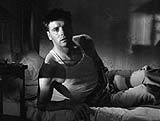 Death of the Swede 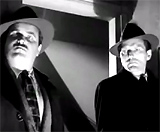
The Killers |
||||||
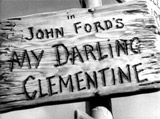
|
In the climactic gunfight at the O.K. Corral recreation in this western, four of the Clanton sons were killed, but Doc Holliday (Victor Mature) was also killed when he suffered a coughing fit and was shot by one of the Clantons. Before any shooting commenced, Wyatt Earp (Henry Fonda) explained how he had warrants charging Old Man Clanton (Walter Brennan) and his sons for the murder of James and Virgil Earp - including a charge of cattle rustling. The town stagecoach riding between Earp and Ike (Grant Withers) billowed up clouds of dust as the oldest Clanton son kicked open the corral gate and walked toward Earp. Using the dust as camouflage, Earp moved closer and fired a shot at Ike, killing him. Morgan Earp (Ward Bond) killed a second Clanton. Next to him, Doc suffered a coughing fit and was shot dead by one of the Clantons. Using horses in the corral as cover, Earp got closer and killed another Clanton in front of a horse trough. Just before he collapsed, Doc killed the fourth Clanton son. Old Man Clanton surrendered to Earp and was banished from town. Old Man Clanton was allowed to ride out of the O.K. Corral - his punishment was to live and feel what Earp's father would soon feel. Suicidally avenging the deaths of his sons, he turned with gun in hand to shoot Wyatt. To defend his brother, Morgan (from the hip) shot Clanton from his saddle. |
 Death of Doc Holliday (with Handkerchief) |
||||||
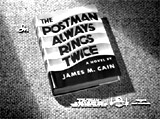
|
The Postman Always Rings Twice (1946) As the star-crossed lovers, now reconciled, drove along the highway and neared their home, Frank (John Garfield) asked for a long-awaited kiss. Cora (Lana Turner) was painting her lips with lipstick:
Distracted during a 'kiss that comes from life' while he was driving, he ran off the road, killing Cora ('with a kiss that comes from death') in a fatal auto accident. The car door opened after the crash - Cora's lifeless arm fell off the seat, and a tube of lipstick slowly dropped to the floor of the car and onto the ground, recalling the scene of their first meeting. |
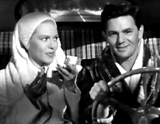 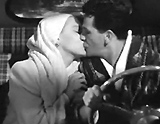 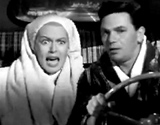 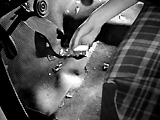 Cora's Death in Car Crash After 'Death' Kiss |
||||||
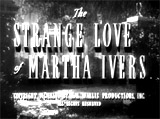
|
The Strange Love of Martha Ivers (1946) In the film's shock ending, Martha Ivers O'Neil (Barbara Stanwyck) suicidally pulled the trigger on herself as her husband Walter (Kirk Douglas) held a gun to her stomach. Then with her draped limply in his arms, Walter shot
himself to death. |
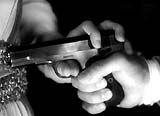 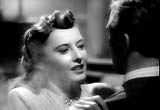 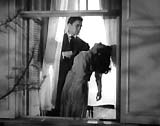 Double Suicide |
||||||
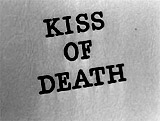
|
Kiss of Death (1947) This little-known film had one of the most notorious death scenes ever recorded. Psychopathic, wild-eyed, giggling killer Tommy Udo (Richard Widmark in his memorable screen debut) asked a crippled, wheelchair-bound woman (Mildred Dunnock) about her squealer son Rizzo. Tommy thought Rizzo had ratted him out:
He responded cruelly. He tied her up in her wheelchair with an electrical cord, and then pushed her down a long flight of stairs to her death as she screamed - he giggled maniacally the whole time. |
 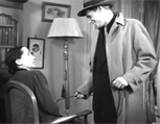 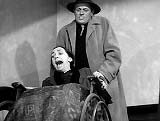 Sadistic and Maniacal Revenge |
||||||
(chronological by film title) Intro | 1915-1929 | 1930-1933 | 1934-1938 | 1939 | 1940-1942 | 1943-1945 | 1946-1947 | 1948-1949 1950-1952 | 1953-1955 | 1956-1957 | 1958-1959 1960-1961 | 1962-1963 | 1964-1966 | 1967-1968 | 1969-1970 1971 | 1972 | 1973 | 1974 | 1975 | 1976 | 1977-1978 | 1979 1980 | 1981 | 1982 | 1983 | 1984 | 1985 | 1986 | 1987 | 1987 | 1988 | 1989 1990 | 1991 | 1992 | 1993 | 1994 | 1994 | 1995 | 1995 | 1996 | 1997 | 1998 | 1998 | 1999 2000-2001 | 2002 | 2003 | 2004 | 2005 | 2006 | 2007 | 2008 | 2009 | 2010 | 2011 |